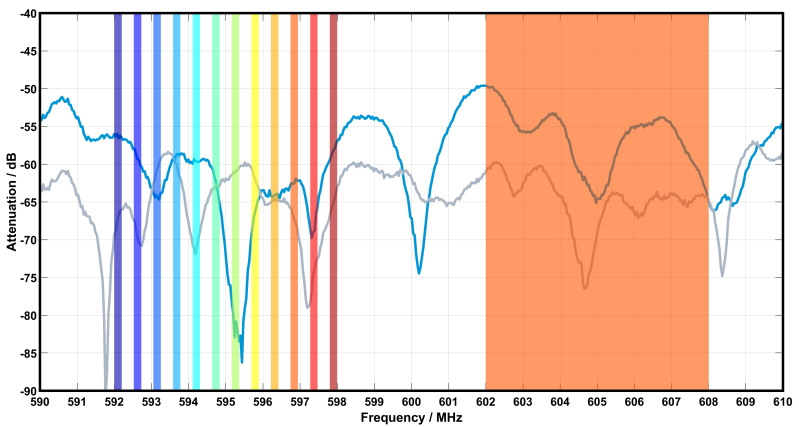Sennheiser applauds the FCC WMAS Report & Order

L-R: Joe Ciaudelli, Dr. Andreas Wilzeck
The Federal Communication Commission (FCC) approved a change in its regulation that now permits operation of Wireless Multichannel Audio Systems (WMAS) in the United States. WMAS is an advanced wireless microphone technology designed to meet the challenges of highly demanding live performance and studio applications. Compared to conventional wireless microphone systems, WMAS offers higher spectral efficiency – the ability to transmit more audio channels within a limited block of radio frequency (RF) spectrum – as well as greater interference protection to other wireless services that share the same spectrum.
In her statement during the Open Commission Meeting, Chairwoman Jessica Rosenworcel pointed out, “Unless you’re in video and audio production, the odds are you haven’t thought much about wireless microphones. But they’re everywhere. […] So when a new technology comes along with the potential to improve the efficiency of wireless microphone operations, we’re going to take a second look. That’s why a few years ago we issued a rulemaking to explore this new type of technology known as Multichannel Wireless Audio Systems or WMAS. […] they can significantly improve the efficiency of wireless microphone operations […] that’s a spectrum win-win.” (Watch the meeting here, WMAS from 27:50.)
Sennheiser started development of its WMAS over ten years ago. In August 2018, Sennheiser filed a Petition for Rulemaking with the FCC requesting a modification in the bandwidth limit specified for wireless microphones by the Commission. At that time, Sennheiser demonstrated a prototype system to the Commission’s Office of Engineering & Technology (OET). During the past five and a half years, the FCC monitored further developments of WMAS technology and concluded that it justified the requested rule change. “We especially thank OET, who carefully studied our claims and supporting evidence,” commented Joe Ciaudelli, Director of Spectrum & Innovation for Sennheiser. “WMAS will revolutionize the professional audio industry as well as fulfil the Commission’s goals of greater spectrum efficiency and sharing compatibility.”
Dr. Andreas Wilzeck, Head of Spectrum Policy and Standards, added: “We applaud the FCC for its adoption of WMAS technology. In particular, the alignment with EN 300 422, which was developed by ETSI, is a milestone for manufacturers and users of wireless microphones and in-ear monitors (IEMs). It is an important signal for the harmonization of regulatory conditions for these important global applications.”
Today, conventional wireless microphones are narrowband, i.e. limited to an RF bandwidth of 200 kHz. Each audio channel uses a dedicated, mono-directional transmitter-receiver pair tuned to a unique RF carrier. Each transmitter continuously outputs power, typically 50 mW, which raises the RF noise floor with each channel that’s added to the configuration. These multiple carriers are also prone to generating non-harmonic distortion products, known as intermodulation (IM), which can interfere with wanted signals.
The benefits of WMAS technology are accomplished by multiplexing audio channels onto a wideband RF channel, which is 6 MHz for the US in the case of Sennheiser’s WMAS technology. In this space, portable bidirectional transceivers will be able to communicate with a base station at an extremely low power spectral density. This will provide superior protection to nearby operators of other wireless devices.
Since WMAS uses a single RF carrier, the possibility of IM products is eliminated. For the first time, in-ear monitor channels will be able to use, in parallel, the same block of RF spectrum as wireless microphones, further enhancing spectral efficiency. “For years customers have been asking for a single pack that is both a transmitter and an in-ear monitor receiver,” states Ciaudelli. “This will finally become possible with Sennheiser’s WMAS.”

“Theater sound designers and engineers face steep challenges because radio frequencies that can be used for wireless microphones and intercom are limited, especially in major cities. The higher audio channel count and easier frequency coordination that WMAS promises is an exciting and welcomed, as well as needed, development.” - Tony Meola, Broadway Sound Designer (Wicked, The Lion King, The King & I, The Sound of Music)
“The sophistication of concerts continues to increase, especially in terms of wireless technology. Suitable radio frequency spectrum for wireless mics and in-ear monitors is scarce in many cities. Thus, WMAS is eagerly anticipated. It’s a thrilling prospect that the audio fidelity, transmission reliability, and low latency for each individual audio channel will be adjustable, such that only the minimum amount of spectral resources will be used to achieve those specifications. The ability to switch those parameters dynamically throughout an event will be a gamechanger, especially for multi-act festivals and award show broadcasts.” - Robert Scovill, Front-of-House Audio Engineer (Kenny Chesney, Tom Petty & the Heartbreakers, Def Leppard, Matchbox 20, Rush, Prince, Rock & Roll Hall of Fame Induction Ceremony)
“Microphones need to work when we make movies. WMAS will keep them working flawlessly in the digital age.” - Chris Newman, Three-Time Academy Award-Winning Engineer (Best Sound) (The Godfather, The Exorcist, The English Patient, Fame, Amadeus, A Chorus Line, The Silence of the Lambs)
“I had the privilege to use an advanced WMAS prototype for a show at the United Nations’ World Radio Conference (WRC-23) in Dubai. I loved it. This FCC rule-change opens the door for the next generation of wireless technologies, allowing progress to continue to the next horizon. I can’t wait to get my hands on a WMAS system again!” - Jason Banta, Audio Engineer / Production Manager (Amos Lee, Better Than Ezra, Sonic Crusaders)
 How to resolve AdBlock issue?
How to resolve AdBlock issue?